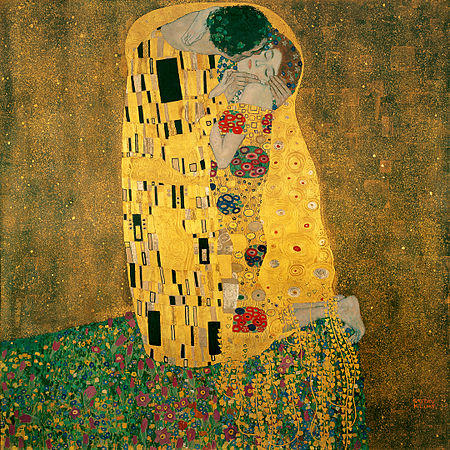Vienna in Austria gradually grew from being a Roman settlement, in the 11th. century it was an important trading site, by the 19th. century it was the capital of the Austrian Empire. Around 1900 the city became the centre of the Art Nouveau movement, Gustave Klimt was prominent in that movement.
Klimt was born in Vienna, the second of seven children, his father was born in Bohemia and was a gold engraver, they were a poor immigrant family. Klimt with two brothers worked together in order to keep the family from starving by painting in theatres, museums and churches, Gustave attended the Vienna Public Art School from the age of fourteen, he is thought by art historians to be one of the most important painters to come out of Vienna. In 1892 he became a member of the Co-Operative Society of Austrian painters, five years later in 1897 he was a founding member of the Seccessionist Movement known as Art Nouveau along with other unconventional artists, their aim was to bring more abstract and purer forms to the design of buildings and furniture, bringing together Naturalists and Modernists. Naturalists were like the Realist movement which included painters such as Courbet who painted to represent subject matter truthfully with no artificiality or supernatural elements, peasants working in a corn field for example, the movement began in France in the 1850s after the 1848 Revolution in Paris. Modernists were a philosophical movement, a factor which influenced them was the modern industrial society. As commented on so many times before in these blogs, the Art Nouveau Movement was another protest group of the younger generation, looking for a separation of the past looking towards the future. Klimt was their first chairman, they created exhibition posters and published a journal called Sacred Spring.
In 1901 Klimt painted ‘Philosophy’ exhibited at the Paris World Fair to great acclaim, winning first prize, he visited Ravenna and Florence in 1904, he resigned from the Seccessionist Movement to create a new association called Art Show. He led a cloistered life as a devoted painter, but he fathered fourteen illegitimate children, all the time successfully managing to keep a low profile on his various relationships, while mixing with and painting portraits of society women. He had a life – long companion, Emilie Louise Floge, thought to be his model for the painting I have chosen called The Kiss. You may know of the Rodin sculpture named The Kiss made between 1901 and 1904.
The Kiss was painted between 1907 and 1908, Klimt found a new style of painting in oils together with an appliction of gold leaf. The clothes the couple are seen wearing are designed by Klimt and made by Emilie Floge, his material has a black and white design, the female figure wears a flowery material with spiral patterns reminiscent of Bronze Age Art, the background is plain, sparkling with bright dots. The painting is thought to celebrate and be a symbol of the attraction of the sexes, there is another version given in a television programme by Dr. James Fox who viewed the painting differently, he thinks that it symbolises something more disturbing, that the woman is not relaxed, not enjoying being kissed, her face is turned away from her partner, her body looks uncomfortable, he thinks that the painting is a symbol of the tensions existing in Vienna at the time, the years leading up to WW1. Symbolist painters and poets looked for inspiration in spirituality, imagination and dreams, was this painting prophetic? Symbolists were anti- idealistic, rather they attempted to ‘ represent reality in its gritty particularity and to elevate the humble and the ordinary over the ideal.’ Shopenahuer thought of ‘Art as a contemplative refuge from the world of strife’. Perhaps you remember an earlier blog about Pierre Bonnard, another Symbolist, one of my favourite painters. This painting is tense but not at all humble with its glittering gold, like a Byzantine mosaic mural I saw in St. Marks in Venice, it has a decadent quality not everyday in appearance. Outwardly Vienna seemed wealthy, rich inhabitants danced at fine balls disregarding the poverty that surrounded them and they denied the undercurrents of rebellion, soon the world would witness the horrors of war.
Klimt died aged forty eight having suffered a stroke followed by pneumonia.

